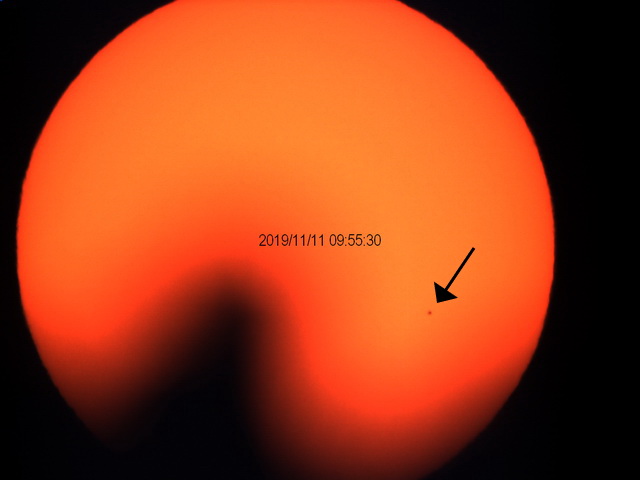The Transit of Mercury is a relatively rare event that amateur astronomers like myself look forward to when the opportunity arises. It only occurs about 13 times each century, and of course is not visible from every location on earth. During this event Mercury passes between Earth and the Sun, and the planet appears as a small black dot moving across the face of the Sun.
The event on this day began at 12:35 UT (05:35 MST), so from my vantage point in Western Canada, the transit started before sun rose above the horizon (about 7:30 AM MST). Of course from sun rise to actual visibility varies due to buildings and trees in the vicinity. Thus, the transit was well under way by the time the sun started peering between the tree tops. However, as the sun continued its progression I was able to watch through the my telescope with solar filter, pausing at times while the sun passed behind tree branches.
At 9:30 AM I setup my small imaging camera, a Point Grey Chameleon using an Altair Astro 70mm OTA as a lens. Initially I was using video mode, capturing 1000 frames at 15 frames per second which provided video clips of about 67 seconds. My field of view was not quite perfect as I was unable to get the full sun to appear in the frame. However, I was still happy with the results, with the top and bottom of the sun chopped off. At least I was able to see Mercury as it made its way across the face. I reduced the length of a couple of these videos to 15 seconds.
For all videos it is best to open them to full size before starting playback. Otherwise Mercury is nearly impossible to see.
Shortly before 10:00 AM my view encountered another obstruction as seen below. At least I could still track Mercury with the tree branch hiding the lower left quadrant of my images.

Once the field of view cleared the last tree branch, I was able to capture the following video which again I have trimmed to 15 seconds duration.
To change things up a bit, I adjusted the settings on my camera to capture and record still images rather than videos. Starting at 10:18:56 I started recording a single frame approximately every minute. At about 10:56 I increased the frequency of the frames to every 10 seconds. Finally, at about 11:01 I increased the frequency to every 5 seconds, and continued this process for the remainder of the event which officially concluded at 11:04:14 MST (18:04:14 UT). I compiled these single frames into the following time lapse. This final video shows more movement since it is covers a longer time frame.
